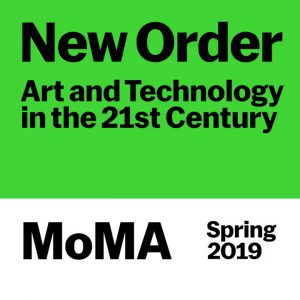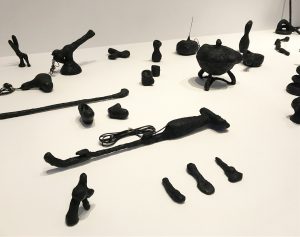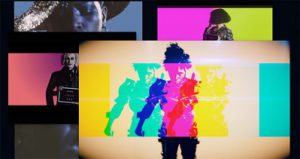
The MOMA’s current exhibition New Order: Art and Technology in the Twenty-First Century is a collection of pieces which blur the lines between the two categories: Art and Technology. The exhibition consisted of various forms of media, sometimes even within just one piece. The artists included in this exhibition are all working to explore technology as something which is physical and tangible, not merely unseen codes and waves. It was very interesting to see the various ways artists are working within, and expanding upon, the place of technology in the future of art.
Of the works on display, I think my favorite, by far, was Made in ‘Eaven by Mark Leckey. The piece was a combined work of film and an accompanying sculptural component. The sculptural component was an EIKI 16mm projector which was positioned to project the film onto the wall in front of it. It is clear that the projector was meant to be seen as a feature of the piece, being that it was placed in a highly visible area and the film was not projected from a ceiling mounted projector. The inclusion of the projector in the piece led to the initial mischaracterization of the projected image as having been captured on film. After further inspection, it was clear that the image was a digital rendering of the artist’s studio and had merely been transferred from its digital form to 16mm.

What interested me so much about this piece was its backwardness. Today, it is so normal to transfer images from their analog form to a more easily handled digital form, but I have never seen this process take place in the opposite direction.
Another of the pieces I really enjoyed was Augmented Objects by Camille Henrot. This piece was made of various domestic objects covered in layers of tar. The artist purchased these objects from various places, including eBay, and then covered them in tar, making them effectively unusable. The statement for the piece described this act as “thwart[ing] the normal flow of objects, commodities, and digital networks of exchange.”

I was intrigued by the objects which were still recognizable, such as the old hair dryer and the TV antennas, but were obviously stunted by their transformation. It made me think about the way technology so quickly becomes obsolete, replaced by something faster, smaller, more functional. These objects also become useless, much in the same way that Henrot has stripped the usefulness from her objects. I also felt as if there was a gender component to be read in the work, being that many of the objects chosen were “domestic” in nature. Do these objects become relics of the domesticized woman of the past? Or does woman’s escape from isolation in the private sphere have an effect on the flow of these objects?

